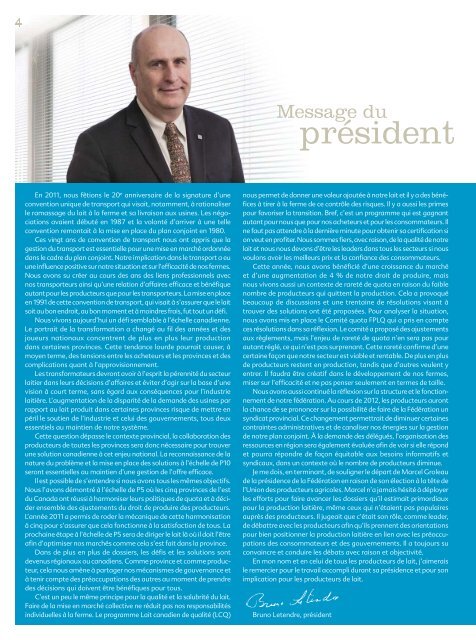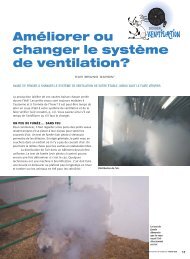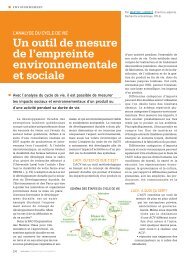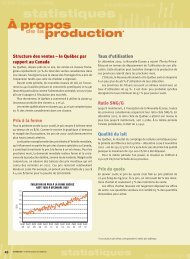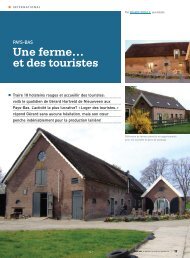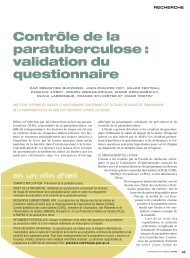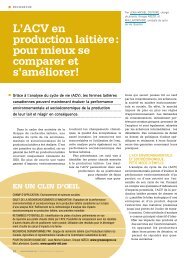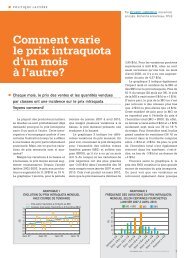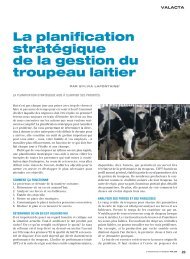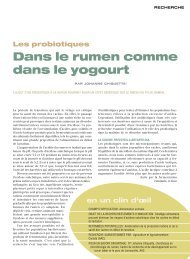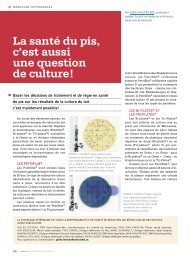président - Fédération des producteurs de lait du Québec
président - Fédération des producteurs de lait du Québec
président - Fédération des producteurs de lait du Québec
Create successful ePaper yourself
Turn your PDF publications into a flip-book with our unique Google optimized e-Paper software.
4<br />
en 2011, nous fêtions le 20 e anniversaire <strong>de</strong> la signature d’une<br />
convention unique <strong>de</strong> transport qui visait, notamment, à rationaliser<br />
le ramassage <strong>du</strong> <strong>lait</strong> à la ferme et sa livraison aux usines. Les négociations<br />
avaient débuté en 1987 et la volonté d’arriver à une telle<br />
convention remontait à la mise en place <strong>du</strong> plan conjoint en 1980.<br />
Ces vingt ans <strong>de</strong> convention <strong>de</strong> transport nous ont appris que la<br />
gestion <strong>du</strong> transport est essentielle pour une mise en marché ordonnée<br />
dans le cadre <strong>du</strong> plan conjoint. notre implication dans le transport a eu<br />
une influence positive sur notre situation et sur l’efficacité <strong>de</strong> nos fermes.<br />
nous avons su créer au cours <strong><strong>de</strong>s</strong> ans <strong><strong>de</strong>s</strong> liens professionnels avec<br />
nos transporteurs ainsi qu’une relation d’affaires efficace et bénéfique<br />
autant pour les <strong>pro<strong>du</strong>cteurs</strong> que pour les transporteurs. La mise en place<br />
en 1991 <strong>de</strong> cette convention <strong>de</strong> transport, qui visait à s’assurer que le <strong>lait</strong><br />
soit au bon endroit, au bon moment et àmoindres frais, fut tout un défi.<br />
nous vivons aujourd’hui un défi semblable à l’échelle canadienne.<br />
Le portrait <strong>de</strong> la transformation a changé au fil <strong><strong>de</strong>s</strong> années et <strong><strong>de</strong>s</strong><br />
joueurs nationaux concentrent <strong>de</strong> plus en plus leur pro<strong>du</strong>ction<br />
dans certaines provinces. Cette tendance lour<strong>de</strong> pourrait causer, à<br />
moyen terme, <strong><strong>de</strong>s</strong> tensions entre les acheteurs et les provinces et <strong><strong>de</strong>s</strong><br />
complications quant à l’approvisionnement.<br />
Les transformateurs <strong>de</strong>vront avoir à l’esprit la pérennité <strong>du</strong> secteur<br />
<strong>lait</strong>ier dans leurs décisions d’affaires et éviter d’agir sur la base d’une<br />
vision à court terme, sans égard aux conséquences pour l’in<strong>du</strong>strie<br />
<strong>lait</strong>ière. L’augmentation <strong>de</strong> la disparité <strong>de</strong> la <strong>de</strong>man<strong>de</strong> <strong><strong>de</strong>s</strong> usines par<br />
rapport au <strong>lait</strong> pro<strong>du</strong>it dans certaines provinces risque <strong>de</strong> mettre en<br />
péril le soutien <strong>de</strong> l’in<strong>du</strong>strie et celui <strong><strong>de</strong>s</strong> gouvernements, tous <strong>de</strong>ux<br />
essentiels au maintien <strong>de</strong> notre système.<br />
Cette question dépasse le contexte provincial, la collaboration <strong><strong>de</strong>s</strong><br />
<strong>pro<strong>du</strong>cteurs</strong> <strong>de</strong> toutes les provinces sera donc nécessaire pour trouver<br />
une solution canadienne à cet enjeu national. La reconnaissance <strong>de</strong> la<br />
nature <strong>du</strong> problème et la mise en place <strong><strong>de</strong>s</strong> solutions à l’échelle <strong>de</strong> P10<br />
seront essentielles au maintien d’une gestion <strong>de</strong> l’offre efficace.<br />
il est possible <strong>de</strong> s’entendre si nous avons tous les mêmes objectifs.<br />
nous l’avons démontré à l’échelle <strong>de</strong> P5 où les cinq provinces <strong>de</strong> l’est<br />
<strong>du</strong> Canada ont réussi à harmoniser leurs politiques <strong>de</strong> quota et à déci<strong>de</strong>r<br />
ensemble <strong><strong>de</strong>s</strong> ajustements <strong>du</strong> droit <strong>de</strong> pro<strong>du</strong>ire <strong><strong>de</strong>s</strong> <strong>pro<strong>du</strong>cteurs</strong>.<br />
L’année 2011 a permis <strong>de</strong> ro<strong>de</strong>r la mécanique <strong>de</strong> cette harmonisation<br />
à cinq pour s’assurer que cela fonctionne à la satisfaction <strong>de</strong> tous. La<br />
prochaine étape à l’échelle <strong>de</strong> P5 sera <strong>de</strong> diriger le <strong>lait</strong> là où il doit l’être<br />
afin d’optimiser nos marchés comme cela s’est fait dans la province.<br />
dans <strong>de</strong> plus en plus <strong>de</strong> dossiers, les défis et les solutions sont<br />
<strong>de</strong>venus régionaux ou canadiens. Comme province et comme pro<strong>du</strong>cteur,<br />
cela nous amène à partager nos mécanismes <strong>de</strong> gouvernance et<br />
à tenir compte <strong><strong>de</strong>s</strong> préoccupations <strong><strong>de</strong>s</strong> autres au moment <strong>de</strong> prendre<br />
<strong><strong>de</strong>s</strong> décisions qui doivent être bénéfiques pour tous.<br />
C’est un peu le même principe pour la qualité et la salubrité <strong>du</strong> <strong>lait</strong>.<br />
Faire <strong>de</strong> la mise en marché collective ne ré<strong>du</strong>it pas nos responsabilités<br />
indivi<strong>du</strong>elles à la ferme. Le programme Lait canadien <strong>de</strong> qualité (LCQ)<br />
Message <strong>du</strong><br />
<strong>prési<strong>de</strong>nt</strong><br />
nous permet <strong>de</strong> donner une valeur ajoutée à notre <strong>lait</strong> et il y a <strong><strong>de</strong>s</strong> bénéfices<br />
à tirer à la ferme <strong>de</strong> ce contrôle <strong><strong>de</strong>s</strong> risques. il y a aussi les primes<br />
pour favoriser la transition. bref, c’est un programme qui est gagnant<br />
autant pour nous que pour nos acheteurs et pour les consommateurs. il<br />
ne faut pas attendre à la <strong>de</strong>rnière minute pour obtenir sa certification si<br />
on veut en profiter. nous sommes fiers, avec raison, <strong>de</strong> la qualité <strong>de</strong> notre<br />
<strong>lait</strong> et nous nous <strong>de</strong>vons d’être les lea<strong>de</strong>rs dans tous les secteurs si nous<br />
voulons avoir les meilleurs prix et la confiance <strong><strong>de</strong>s</strong> consommateurs.<br />
Cette année, nous avons bénéficié d’une croissance <strong>du</strong> marché<br />
et d’une augmentation <strong>de</strong> 4 % <strong>de</strong> notre droit <strong>de</strong> pro<strong>du</strong>ire, mais<br />
nous vivons aussi un contexte <strong>de</strong> rareté <strong>de</strong> quota en raison <strong>du</strong> faible<br />
nombre <strong>de</strong> <strong>pro<strong>du</strong>cteurs</strong> qui quittent la pro<strong>du</strong>ction. Cela a provoqué<br />
beaucoup <strong>de</strong> discussions et une trentaine <strong>de</strong> résolutions visant à<br />
trouver <strong><strong>de</strong>s</strong> solutions ont été proposées. Pour analyser la situation,<br />
nous avons mis en place le Comité quota FPLQ qui a pris en compte<br />
ces résolutions dans sa réflexion. Le comité a proposé <strong><strong>de</strong>s</strong> ajustements<br />
aux règlements, mais l’enjeu <strong>de</strong> rareté <strong>de</strong> quota n’en sera pas pour<br />
autant réglé, ce qui n’est pas surprenant. Cette rareté confirme d’une<br />
certaine façon que notre secteur est viable et rentable. <strong>de</strong> plus en plus<br />
<strong>de</strong> <strong>pro<strong>du</strong>cteurs</strong> restent en pro<strong>du</strong>ction, tandis que d’autres veulent y<br />
entrer. il faudra être créatif dans le développement <strong>de</strong> nos fermes,<br />
miser sur l’efficacité et ne pas penser seulement en termes <strong>de</strong> taille.<br />
nous avons aussi continué la réflexion sur la structure et le fonctionnement<br />
<strong>de</strong> notre fédération. au cours <strong>de</strong> 2012, les <strong>pro<strong>du</strong>cteurs</strong> auront<br />
la chance <strong>de</strong> se prononcer sur la possibilité <strong>de</strong> faire <strong>de</strong> la <strong>Fédération</strong> un<br />
syndicat provincial. Ce changement permettrait <strong>de</strong> diminuer certaines<br />
contraintes administratives et <strong>de</strong> canaliser nos énergies sur la gestion<br />
<strong>de</strong> notre plan conjoint. À la <strong>de</strong>man<strong>de</strong> <strong><strong>de</strong>s</strong> délégués, l’organisation <strong><strong>de</strong>s</strong><br />
ressources en région sera également évaluée afin <strong>de</strong> voir si elle répond<br />
et pourra répondre <strong>de</strong> façon équitable aux besoins informatifs et<br />
syndicaux, dans un contexte où le nombre <strong>de</strong> <strong>pro<strong>du</strong>cteurs</strong> diminue.<br />
Je me dois, en terminant, <strong>de</strong> souligner le départ <strong>de</strong> Marcel Groleau<br />
<strong>de</strong> la prési<strong>de</strong>nce <strong>de</strong> la <strong>Fédération</strong> en raison <strong>de</strong> son élection à la tête <strong>de</strong><br />
l’union <strong><strong>de</strong>s</strong> <strong>pro<strong>du</strong>cteurs</strong> agricoles. Marcel n’a jamais hésité à déployer<br />
les efforts pour faire avancer les dossiers qu’il estimait primordiaux<br />
pour la pro<strong>du</strong>ction <strong>lait</strong>ière, même ceux qui n’étaient pas populaires<br />
auprès <strong><strong>de</strong>s</strong> <strong>pro<strong>du</strong>cteurs</strong>. il jugeait que c’était son rôle, comme lea<strong>de</strong>r,<br />
<strong>de</strong> débattre avec les <strong>pro<strong>du</strong>cteurs</strong> afin qu’ils prennent <strong><strong>de</strong>s</strong> orientations<br />
pour bien positionner la pro<strong>du</strong>ction <strong>lait</strong>ière en lien avec les préoccupations<br />
<strong><strong>de</strong>s</strong> consommateurs et <strong><strong>de</strong>s</strong> gouvernements. il a toujours su<br />
convaincre et con<strong>du</strong>ire les débats avec raison et objectivité.<br />
en mon nom et en celui <strong>de</strong> tous les <strong>pro<strong>du</strong>cteurs</strong> <strong>de</strong> <strong>lait</strong>, j’aimerais<br />
le remercier pour le travail accompli <strong>du</strong>rant sa prési<strong>de</strong>nce et pour son<br />
implication pour les <strong>pro<strong>du</strong>cteurs</strong> <strong>de</strong> <strong>lait</strong>.<br />
bruno Letendre, <strong>prési<strong>de</strong>nt</strong>
Message fRoM The ChaiRMan<br />
FPLQ rapport annuel 2011 5<br />
In 2011, we celebrated the 20th anniversary of the signature of a single transportation agreement whose primary purpose was to streamline<br />
the collection and transportation of milk from the farm to the plants. While the negotiations began in 1987, the conclusion of such an agreement<br />
had been a goal ever since the Joint Plan was implemented in 1980.<br />
our experience over the past twenty years has <strong>de</strong>monstrated that the management of transportation is essential for or<strong>de</strong>rly marketing un<strong>de</strong>r the<br />
Joint Plan. our involvement in transportation has had a positive effect on our economic situation and the efficiency of our farms. over the years,<br />
we established professional relations with the milk transporters as well as an efficient and profitable business relationship for both pro<strong>du</strong>cers and<br />
transporters. This transportation agreement was <strong><strong>de</strong>s</strong>igned to ensure that milk is transported at low cost and is at the right place, at the right time.<br />
Its implementation in 1991 was quite a challenge.<br />
Today, we are experiencing a similar challenge at the Canadian level. The milk processing structure has changed over the years and national<br />
players are increasingly consolidating their activities in certain provinces. In the medium term, this clear trend could cause tension between buyers<br />
and provinces and complicate supplies.<br />
Processors should keep the sustainability of the dairy sector in mind in their business <strong>de</strong>cisions rather than act from a short-term perspective<br />
regardless of the consequences for the dairy in<strong>du</strong>stry. The increasing difference between milk <strong>de</strong>mand and supply in certain provinces risks jeopardizing<br />
support from in<strong>du</strong>stry and governments, both of which are essential to maintain our system.<br />
This matter goes beyond a provincial context and requires the collaboration of pro<strong>du</strong>cers in all provinces to achieve a Canadian solution to a<br />
national issue. To maintain an efficient supply management system, it is essential to recognize the nature of the problem and put solutions in place<br />
that involve the P10 provinces.<br />
It is possible to reach a solution if we all have the same objectives. This was <strong>de</strong>monstrated at the P5 level where the five provinces of Eastern<br />
Canada succee<strong>de</strong>d in harmonizing their quota policies and collectively <strong>de</strong>ciding on adjustments to pro<strong>du</strong>cers’ pro<strong>du</strong>ction entitlement. In 2011 efforts<br />
were ma<strong>de</strong> to fine tune the five-way harmonization mechanism to ensure that it functions satisfactorily for everyone. The next step within the P5<br />
group will be to direct the milk where it is nee<strong>de</strong>d so as to optimize our markets, as was done in the province.<br />
The challenges and solutions for an increasing number of issues have become regional or Canadian in scope. Thus, as provinces and as pro<strong>du</strong>cers,<br />
we need to share our governance mechanisms and consi<strong>de</strong>r the concerns of others in our <strong>de</strong>cision-making so that everyone benefits.<br />
The same principle applies to the quality and wholesomeness of milk. Marketing milk collectively does not re<strong>du</strong>ce our indivi<strong>du</strong>al responsibilities.<br />
The Canadian Quality Milk (CQM) program enables us to add value to our milk. In addition, controlling quality hazards can result in benefits at the<br />
farm. Quality premiums are also granted to encourage the transition to certified farms. In short, CQM is a winning program for pro<strong>du</strong>cers, buyers<br />
and consumers. To benefit from it, we must not wait until the last minute to complete the certification requirements. We are rightfully proud of the<br />
quality of our milk and we must lead the way in all commodity sectors if we want to earn top prices and the trust of consumers.<br />
This year, we benefited from market growth and a four per cent quota increase, but we also faced a quota shortage because of the low number<br />
of pro<strong>du</strong>cers who give up dairy farming. This prompted many discussions and some thirty resolutions were proposed in an effort to find solutions.<br />
To analyze the situation, we set up the FPlQ Quota Committee which inclu<strong>de</strong>d these resolutions in its study process. The committee recommen<strong>de</strong>d<br />
adjustments to the regulations, but this, unsurprisingly, will not resolve the quota shortage. In a way, this situation confirms that our in<strong>du</strong>stry is<br />
viable and profitable. Increasingly, pro<strong>du</strong>cers remain in pro<strong>du</strong>ction, while others wish to enter the business. In <strong>de</strong>veloping our farms, we will have<br />
to be creative and focus on increasing efficiency rather than simply expanding the size of our farms.<br />
We also continued discussions on our Fe<strong>de</strong>ration’s administrative structure and operations. During 2012, pro<strong>du</strong>cers will be given an opportunity<br />
to vote on the possibility of converting the Fe<strong>de</strong>ration into a provincial union. This change will re<strong>du</strong>ce the administrative bur<strong>de</strong>n and focus our<br />
energies on the management of our Joint Plan. As requested by <strong>de</strong>legates, the organization of resources in the administrative regions will also be<br />
assessed to <strong>de</strong>termine if it meets, and will continue to equitably meet, information and union needs, in a context of <strong>de</strong>clining pro<strong>du</strong>cer numbers.<br />
In closing, I would like to pay tribute to Marcel Groleau who resigned as chairman of the Fe<strong>de</strong>ration following his election at the head of the<br />
Union <strong><strong>de</strong>s</strong> <strong>pro<strong>du</strong>cteurs</strong> agricoles. Marcel spared no effort to achieve progress in areas he consi<strong>de</strong>red essential for dairy farmers, even those unpopular<br />
with pro<strong>du</strong>cers. he felt it was his role, as lea<strong>de</strong>r, to engage with pro<strong>du</strong>cers and provi<strong>de</strong> information to enable them to effectively position the dairy<br />
sector and, in so doing, reflect the concerns of consumers and governments. he always had a knack for con<strong>du</strong>cting <strong>de</strong>bates with logic and objectivity.<br />
In my name and on behalf of all milk pro<strong>du</strong>cers, I wish to thank him for the work accomplished <strong>du</strong>ring his years as chairman and for his<br />
commitment to milk pro<strong>du</strong>cers.<br />
Bruno letendre, Chairman


